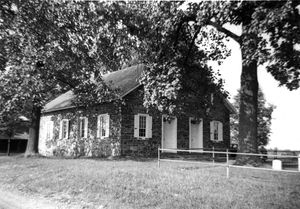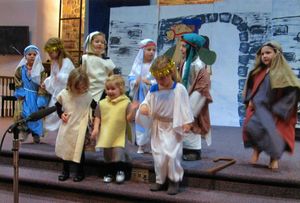Difference between revisions of "Swamp Mennonite Church (Quakertown, Pennsylvania, USA)"
| [checked revision] | [checked revision] |
SamSteiner (talk | contribs) (→Map: added map) |
SamSteiner (talk | contribs) (added categories) |
||
| Line 8: | Line 8: | ||
In 1842, [[Oberholtzer, John H. (1809-1895)|John H. Oberholtzer]] was chosen by lot to be minister. Oberholtzer was self-educated and an eloquent speaker. He was concerned about the teaching of children and [[Discipline, Church|discipline]] of members. He pushed for the congregation and conference of ministers to keep record of their intentions and actions in the form of written constitutions and minutes. These ideas had significant minority support among Mennonites throughout eastern Pennsylvania. | In 1842, [[Oberholtzer, John H. (1809-1895)|John H. Oberholtzer]] was chosen by lot to be minister. Oberholtzer was self-educated and an eloquent speaker. He was concerned about the teaching of children and [[Discipline, Church|discipline]] of members. He pushed for the congregation and conference of ministers to keep record of their intentions and actions in the form of written constitutions and minutes. These ideas had significant minority support among Mennonites throughout eastern Pennsylvania. | ||
| − | At that time, the Swamp congregation had two meetinghouses. One Sunday they would meet at East Swamp and the next at West Swamp. The majority of the Swamp congregation supported John Oberholtzer, but at least seven families were so at odds with the progressive minister that they invited another minister to preach for them at West Swamp on a Sunday when the main congregation was to meet at East Swamp. But the trustees had gotten word of the plan and decided to withhold the key to the West Swamp building so that the group gathered there would be unable to get inside. | + | At that time, the Swamp congregation had two meetinghouses. One Sunday they would meet at [[East Swamp Church (Quakertown, Pennsylvania, USA)|East Swamp]] and the next at [[West Swamp Mennonite Church (Quakertown, Pennsylvania, USA)|West Swamp]]. The majority of the Swamp congregation supported John Oberholtzer, but at least seven families were so at odds with the progressive minister that they invited another minister to preach for them at West Swamp on a Sunday when the main congregation was to meet at East Swamp. But the trustees had gotten word of the plan and decided to withhold the key to the West Swamp building so that the group gathered there would be unable to get inside. |
It was probably the following Friday when the members who, as they put it, "favored the old rules and customs of the Mennonite Church," met to consult with one another on whether it was "proper, advisable or necessary" to build a new meetinghouse for their group. They voted unanimously to build; and so the first meetinghouse of what is today Swamp Mennonite Church was built in 1847 on land donated by Philip Geissinger. | It was probably the following Friday when the members who, as they put it, "favored the old rules and customs of the Mennonite Church," met to consult with one another on whether it was "proper, advisable or necessary" to build a new meetinghouse for their group. They voted unanimously to build; and so the first meetinghouse of what is today Swamp Mennonite Church was built in 1847 on land donated by Philip Geissinger. | ||
| Line 115: | Line 115: | ||
[[Map:Swamp Mennonite Church (Quakertown, Pennsylvania, USA)]] | [[Map:Swamp Mennonite Church (Quakertown, Pennsylvania, USA)]] | ||
{{GAMEO_footer|hp=|date=March 2014|a1_last=Yothers|a1_first=Arlene Geissinger|a2_last=|a2_first=}} | {{GAMEO_footer|hp=|date=March 2014|a1_last=Yothers|a1_first=Arlene Geissinger|a2_last=|a2_first=}} | ||
| + | |||
| + | [[Category:Churches]] | ||
| + | [[Category:Mennonite Church (MC) Congregations]] | ||
| + | [[Category:Mennonite Church USA Congregations]] | ||
| + | [[Category:Franconia Mennonite Conference Congregations]] | ||
Revision as of 19:43, 6 March 2014
Mennonites from Switzerland and South Germany settled in northern Bucks County, Pennsylvania as early as 1717, in an area called the “Great Swamp” by English land agents. The name suggests land too wet for farming, but as trees were cleared and drainage improved, rich soil provided good farmland for Mennonites and their neighbors. For the next two centuries, most residents were Germans, and they continued to call the area Swamp, though the official name of the township is Milford.
In 1735, the Swamp Mennonite congregation erected a meetinghouse on land owned by Philadelphia mayor William Allen, who sold the tract in 1743 to Mennonite preacher Jacob Musselman. In 1790 the congregation moved to a different location nearby, along the Allentown Road. A monument marks the site of the first meetinghouse on Brick Tavern Road, northwest of Quakertown.
In 1842, John H. Oberholtzer was chosen by lot to be minister. Oberholtzer was self-educated and an eloquent speaker. He was concerned about the teaching of children and discipline of members. He pushed for the congregation and conference of ministers to keep record of their intentions and actions in the form of written constitutions and minutes. These ideas had significant minority support among Mennonites throughout eastern Pennsylvania.
At that time, the Swamp congregation had two meetinghouses. One Sunday they would meet at East Swamp and the next at West Swamp. The majority of the Swamp congregation supported John Oberholtzer, but at least seven families were so at odds with the progressive minister that they invited another minister to preach for them at West Swamp on a Sunday when the main congregation was to meet at East Swamp. But the trustees had gotten word of the plan and decided to withhold the key to the West Swamp building so that the group gathered there would be unable to get inside.
It was probably the following Friday when the members who, as they put it, "favored the old rules and customs of the Mennonite Church," met to consult with one another on whether it was "proper, advisable or necessary" to build a new meetinghouse for their group. They voted unanimously to build; and so the first meetinghouse of what is today Swamp Mennonite Church was built in 1847 on land donated by Philip Geissinger.
From 1847 until 1887 the only services were Sunday morning services held every other week. In 1887 a Sunday school was started and continued until 1895, though it probably was not held during winter. Sunday school was started again in 1916. Summer Bible School began in 1948. In 1951, the congregation voted to have weekly worship services.
Jacob Beidler was the first minister of the newly formed congregation in 1847. Abraham Young and John Beidler followed. Then for several years the congregation was without a resident minister and was served by those of neighboring congregations. John G. Gehman was ordained in 1919. He served alone until 1929, when David L. Gehman, a minister from Doylestown, moved into the area and assisted him.
In these early years, all services were in German. When ministers did begin to preach in English, some people found it hard to believe that English sermons were acceptable to God. The last sermon preached in German at Swamp was most likely given by bishop Jonas Mininger at the communion service in June 1930.
Over the years, the horses and buggies that were used to bring families to church were replaced by cars, and the German language was replaced by English. But the building remained basically the same for a hundred years. In 1947, the basement was dug out to install a modern heating system. As activity and outreach of the congregation increased, further projects were undertaken to improve the meetinghouse in the 1960s and 1970s. In 1990-91, a large new sanctuary was added to the east end of the meetinghouse.
In 1991 the growing congregation included many youth and children. A half-time youth pastor position was begun. In 2009, a music and worship minister position was established to encourage the "blended worship style" that had become a priority during a reorganization and revisioning process in 2007 under the leadership of intentional interim pastor Bob Petersheim. Swamp Mennonite Church’s purpose statement in 2013 was to "celebrate God’s grace, encourage growth in Christ and boldly proclaim the victory of Christ’s love over sin and death; through the power of God’s Holy Spirit."
Bibliography
Ruth, John L. Maintaining the Right Fellowship: A Narrative Account of Life in the Oldest Mennonite Community in North America. Scottdale, PA: Herald Press, 1984.
Wenger, John C. History of the Mennonites of the Franconia Conference. Telford, PA: Franconia Mennonite Historical Society, 1937: 125-128.
Additional Information
Address: 2125 Rosedale Road, Quakertown, Pennsylvania
Phone: 215-536-7928
Website: www.justswamp.com
Denominational Affiliations:
Franconia Mennonite Conference
Mennonite Church USA
Swamp Mennonite Church Pastors
| Name | Years of Service |
|---|---|
| Jacob Beidler | 1848-1874 |
| Abraham Young | 1863-1881 |
| John Beidler | 1874-1912 |
| John Gehman | 1919-1966 |
| David Gehman | 1929-1932 |
| Abram Yoder | 1935-1960 |
| Winfield Ruth | 1961-1977 |
| Noah Kolb | 1977-1987 |
| Eli Beachy (Interim) |
1987/1988 |
| William Brunk | 1988-2007 |
| Robert Miller (Youth) |
1991-1993 |
| Donald Pryor (Youth) |
1996-1999 |
| Eric Horst (Youth) |
2000-2006 |
| Jathan Brubaker (Youth) |
2006-2007 |
| Robert Petersheim (Interim) |
2007-2009 |
| Emily Ralph (Worship) |
2009-2011 |
| J. Mark & Emma Frederick (Interim) |
2009-2010 |
| Verle Brubaker | 2010-Present |
| Nathan Good (Worship & Youth) |
2011-Present |
Swamp Mennonite Church Membership
| Year | Members |
|---|---|
| 1914 | 29 |
| 1925 | 41 |
| 1935 | 50 |
| 1945 | 52 |
| 1955 | 81 |
| 1965 | 74 |
| 1975 | 131 |
| 1985 | 122 |
| 1995 | 143 |
| 2005 | 215 |
| 2013 | 153 |
Original Mennonite Encyclopedia Article
By John C. Wenger. Copied by permission of Herald Press, Harrisonburg, Virginia, and Waterloo, Ontario, from Mennonite Encyclopedia, Vol. 4, p. 666. All rights reserved. For information on ordering the encyclopedia visit the Herald Press website.
Swamp Mennonite Church (Mennonite Church), located in Milford Township, Bucks County, Pennsylvania, a member of the Franconia Conference, dates back to the early 18th century. Bishop Falentine ("Veite") Clemmer immigrated from Europe to the Swamp area in 1717. The first meetinghouse was built about 1735, a mile west of the present West Swamp Church (General Conference Mennonite Church). It was torn down and rebuilt on the site of the present West Swamp Church in 1790. The East Swamp (General Conference Mennonite) meetinghouse was built in 1771, and was later destroyed by fire and rebuilt; the present church was erected in 1850. In the Franconia Conference division of 1847 John H. Oberholtzer and the majority of the Milford Township ministers withdrew from the conference and claimed both meetinghouses. Those who were left, although without a minister, immediately built the Swamp meetinghouse for the group adhering to the Franconia Conference. Soon Jacob Beidler (1809-1874) was ordained. In 1863 Abraham Young was ordained to assist him, but was later silenced. Later ministers were John A. Beidler (1840-1912) and the 1958 ministers, John G. Gehman (1875- ), ordained in 1919, and Abram D. Yoder (1893- ), ordained in 1935. The membership in 1958 was 75. John H. Oberholtzer was ordained preacher at Swamp in 1842.
Map
Map:Swamp Mennonite Church (Quakertown, Pennsylvania, USA)
| Author(s) | Arlene Geissinger Yothers |
|---|---|
| Date Published | March 2014 |
Cite This Article
MLA style
Yothers, Arlene Geissinger. "Swamp Mennonite Church (Quakertown, Pennsylvania, USA)." Global Anabaptist Mennonite Encyclopedia Online. March 2014. Web. 24 Nov 2024. https://gameo.org/index.php?title=Swamp_Mennonite_Church_(Quakertown,_Pennsylvania,_USA)&oldid=115083.
APA style
Yothers, Arlene Geissinger. (March 2014). Swamp Mennonite Church (Quakertown, Pennsylvania, USA). Global Anabaptist Mennonite Encyclopedia Online. Retrieved 24 November 2024, from https://gameo.org/index.php?title=Swamp_Mennonite_Church_(Quakertown,_Pennsylvania,_USA)&oldid=115083.
©1996-2024 by the Global Anabaptist Mennonite Encyclopedia Online. All rights reserved.

